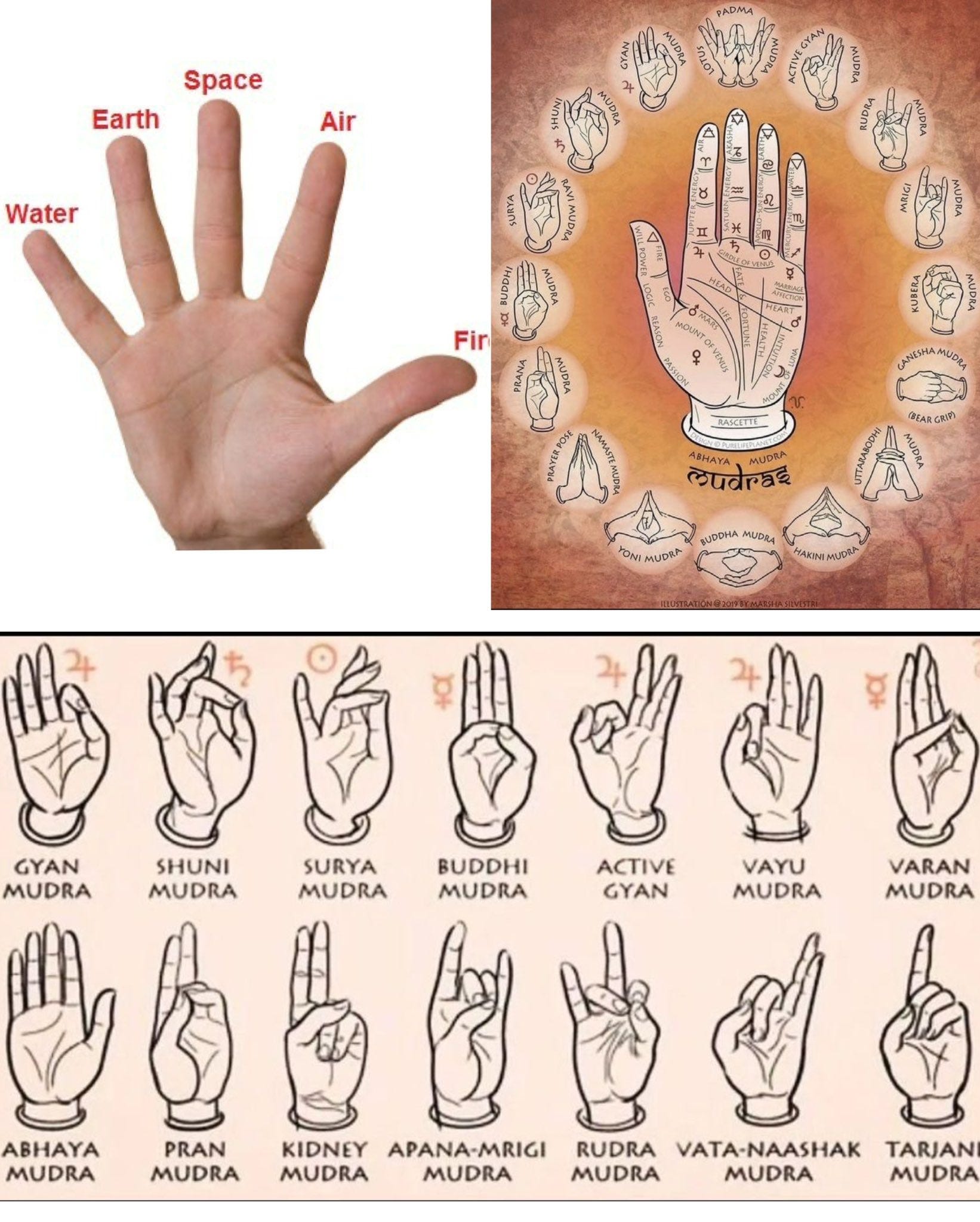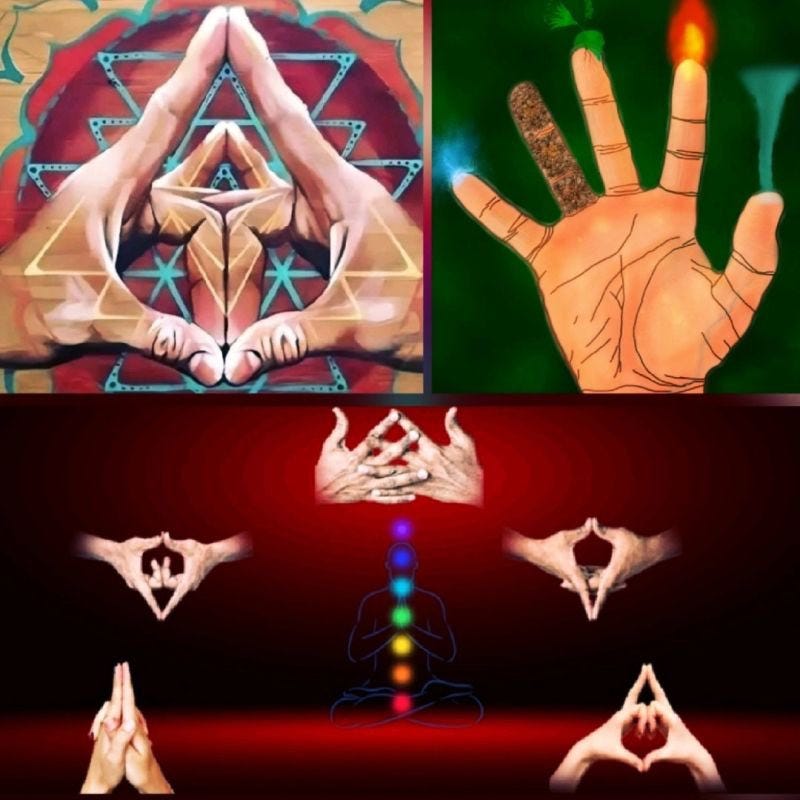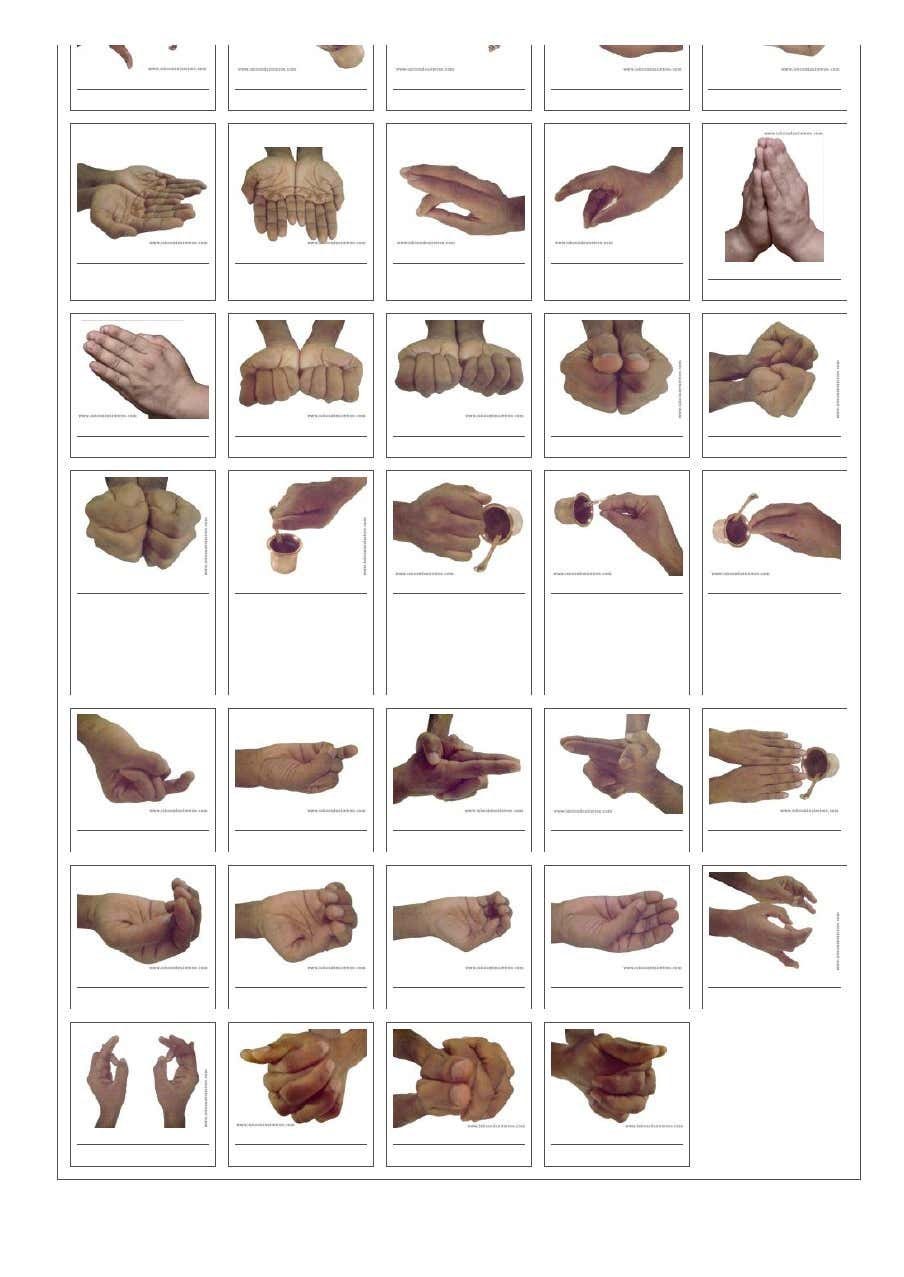🕉️ The Mystical Power of Mudras: The Hidden Science of Spiritual Practice
🕉️ मुद्राओं का रहस्य और साधना में उनका परम महत्व
You may have heard about mudras many times, but have you ever tried to understand their deeper significance?
In the sacred realm of spiritual practices, tantra, and agamas, mudras hold an irreplaceable and exalted place.
Mudras are not merely symbolic hand gestures — they are sacred energetic seals that link the worshipper to the divine consciousness.
Through specific mudras, a practitioner can connect deeply with their chosen deity (Ishta Devata) and attain rapid spiritual success.
This article aims to reveal the complete mystical science of mudras, as preserved in ancient Indian traditions.
Let us dive deeply into this esoteric knowledge.
✨ The Meaning of the Word 'Mudra'
The word "Mudra" has profound roots in Sanskrit:
"Mu" — meaning to delight or give joy to all gods and divine beings.
"Da" — meaning to melt away or destroy all sinful tendencies and karmic impurities.
Scriptural Proof:
"Godanāt sarva devānām drāvaṇāt pāpa santateḥ।
Tasmān mudrāti vikhyātā munibhis tantravedibhiḥ।।"
Meaning:
By forming mudras, one gives bliss to all deities and simultaneously destroys one's karmic sins.
Thus, sages and seers who mastered the tantric sciences termed these sacred hand formations as "Mudras."
🌼 The Role and Importance of Mudras in Tantra and Worship
As stated in Sharada Tilaka Tantra (23/106):
"Mudrāḥ pravakṣyāmi yāmi mādante sarva-devatāḥ"
(“I shall now describe the mudras, seeing which all the deities rejoice.”)
In spiritual rituals, mudras are absolutely essential at every stage:
Invocation (Aavahan) of deities
Offering rituals (such as gandha, pushpa, dhoop, naivedya)
Nyasa (energy installation) practices
Japa (mantra chanting)
Homa (fire offerings)
Sacred baths and water invocation rituals
In traditional scriptures (Kalpa Granthas), it is strictly instructed that appropriate mudras must be formed during rituals to please the deities, remove sins, and invite divine energies into the sacred space.
Without mudras, a ritual or spiritual practice is considered incomplete and ineffective.
🔥 Specific Mudras for Different Spiritual Operations
According to the Tantra scriptures, different categories of spiritual acts require specific mudras:
According to the sacred teachings of the Tantra scriptures, each category of spiritual activity requires the use of a specific mudra to channel and direct the appropriate divine energies effectively.
For acts of peace (Shanti), the Padma Mudra (Lotus Mudra) is prescribed. The lotus symbolizes purity, serenity, and transcendence, and this mudra invokes calming and harmonious energies into the ritual.
For works of enchantment and attraction (Vashikaran), the Pasha Mudra (Noose Mudra) is used. Just as a noose can capture and hold, this mudra symbolically binds the energies of attraction and influence towards the practitioner’s intention.
For purposes of immobilization and stilling hostile forces (Stambhan), the Gada Mudra (Mace Mudra) is performed. The mace signifies power and authority, and this mudra empowers the practitioner to halt obstacles or adversaries.
When one needs to engage in creating hatred or division among enemies (Vidveshan), the Musala Mudra (Pestle Mudra) is employed. The pestle, a symbol of crushing and grinding, represents the disintegration of relationships or opposition forces when necessary.
For the uprooting, banishment, or driving away of negativity and harmful influences (Ucchatan), the Vajra Mudra (Thunderbolt Mudra) is utilized. The thunderbolt symbolizes irresistible force and indestructibility, ensuring the practitioner’s energy sweeps away obstructions.
Finally, for the most severe operations involving destruction (Maran), the Kharga Mudra (Sword Mudra) is adopted. The sword signifies cutting through ignorance, obstacles, and enemies, thereby protecting the practitioner and fulfilling divine justice.
Each mudra acts as a spiritual weapon or tool, harmonizing the physical, mental, and subtle energies of the practitioner with cosmic forces to accomplish the specific spiritual operation intended.
Mudras in Fire Rituals (Homa):
In the sacred science of Tantra and Vedic rituals, Homa (fire offerings) holds a highly significant place. During Homa, specific Mudras are prescribed depending on the nature of the spiritual operation, to channel energies correctly into the sacred fire (Agni). Each Mudra acts as an energetic key that aligns the offering with cosmic forces.
For peaceful and nourishing rituals (Shanti and Pushti Homas), the Mrigi Mudra (Deer Mudra) is used. The deer symbolizes gentleness, tranquility, and graceful movement of energies. By forming Mrigi Mudra during the offering, the practitioner invites serenity, healing, and abundance into the environment.
When performing enchantment and attraction rituals (Vashikaran Homas), the Hansi Mudra (Swan Mudra) is utilized. The swan represents divine beauty, purity, and the ability to distinguish truth from illusion. Using Hansi Mudra during the fire offering enhances the magnetic charm and the power of loving attraction towards the desired goal.
For more forceful operations such as immobilization (Stambhan), hatred creation (Vidveshan), uprooting (Ucchatan), or even destruction rituals (Maran Homas), the Sukari Mudra (Boar Mudra) is employed. The boar is a symbol of fearlessness, uprooting hidden dangers, and brutal strength. Performing fire offerings with Sukari Mudra directs fierce, transformative energy into the cosmos, ensuring that adversities are destroyed, negativity is banished, and the practitioner's purpose is fulfilled.
Thus, each Mudra during Homa is not just symbolic, but a powerful energetic action ensuring that the sacred fire becomes a dynamic conduit between the human prayer and divine manifestation.
These mudras channelize specific energies through the practitioner, ensuring the success of the ritual.
🔥 Importance of Mudras During Havan (Agni Karya)
In the ancient Vedic and Tantric traditions, Havan (Agni Karya) — the sacred fire ritual — is not merely an offering of materials into fire; it is a cosmic communication, a dialogue between the human soul and the divine cosmic forces through Agni, the fire god.
Agni, as per the Rigveda, is the divine messenger (Devanam Doot) who carries human prayers, offerings, and intentions to the celestial beings (Devas).
However, for the transmission of these sacred energies to be precise, potent, and fully effective, it is not enough to merely chant mantras and offer physical substances.
The physical body, especially the hands, must also become active participants in channeling energy.
Thus, Mudras during Havan were ordained by ancient sages as mandatory ritual actions.
🕉️ Scriptural Reasoning:
Rigveda and Yajurveda both emphasize that rituals should be performed not only with correct mantras but also with correct gestures.
According to Tantric Agama Shastras, the hands are extensions of the subtle body (Sukshma Sharira), and through specific formations (Mudras), they can create energy patterns that seal the intention and empower the offerings.
Mudras during Agni Karya ensure that:
The offering is sanctified at the energetic level.
The intention behind the offering is imprinted vibrationally into the fire.
Devas recognize and accept the offering with delight and blessings.
In fact, ancient sages described that without the appropriate Mudra, even the most elaborate Havan risks becoming ritualistically barren (Shramaphalam, meaning fruitless labor).
✨ Connection Between Mudras, Agni, and Devas
Mudras act as energetic signatures that tell Agni which Deity or cosmic power the offering is intended for.
Each Mudra resonates at a particular frequency aligned with a specific Deva or spiritual operation (e.g., Peace, Attraction, Destruction).
When the practitioner forms the correct Mudra while offering to Agni:
Agni recognizes the vibration and directs the offering appropriately to the intended divine recipient.
The Devas become pleased and respond more swiftly and benevolently.
Thus, Mudras empower, authenticate, and spiritualize the Havan, making it not just a physical offering, but a divine transmission.
🌟 Favorite Mudras of Major Deities
🌑 Favorite Mudras of Lord Vishnu (19 Mudras)
Shankha (Conch), Chakra (Disc), Gada (Mace), Padma (Lotus), Venu (Flute), Bhrivatsa (Sacred mark), Kaustubha (Gem), Vanamala (Garland), Jnana (Knowledge), Bilva (Bel Leaf), Garuda (Eagle), Narasimhī (Man-lion form), Varahi (Boar form), Hayagriva (Horse-headed form), Dhanush-Bana (Bow-Arrow), Parashu (Axe), Jaganmohanika (World-enchanting), Kama (Desire).
🌑 Favorite Mudras of Goddess Durga (9 Mudras)
Pasha (Noose), Ankusha (Elephant Goad), Vara (Boon-giving), Abhaya (Fearlessness), Khadga (Sword), Charma (Shield), Dhanush-Bana (Bow-Arrow), Musala (Pestle).
🌑 Favorite Mudras of Lord Shiva (10 Mudras)
Linga (Phallus symbol), Yoni (Womb symbol), Trishula (Trident), Mala (Rosary), Vara (Boon-giving), Mriga (Deer), Abhaya (Fearlessness), Khatvanga (Club), Kapala (Skull cup), Damru (Small drum).
🌑 Favorite Mudras of Goddess Shyama and Shakti
Shyama: Matsya (Fish), Murma (Hidden energy), Lelihaana (Tongue out) Mudras, along with Munda (Severed Head) Mudra.
Shakti: Matsya, Murma, Lelihaana, and Maha-Yoni (Great Womb) Mudra.
🌑 Favorite Mudras of Goddess Tara (5 Mudras)
Yoni (Womb), Bhutini (Spiritual entity), Beeja Daitya (Seed demon), Dhumini (Smoke-form), Lelihaana (Tongue out).
🌑 Favorite Mudras of Goddess Tripurasundari (10 Mudras)
Sankshobhini (Agitator), Dravani (Melter), Akarshini (Attractor), Vashya (Subjugator), Unmada (Deluder), Mahakunchika (Great Hook), Khechari (Sky-mover), Beeja (Seed), Yoni (Womb), and Trikhanda (Three-parted) Mudras.
Special Insight:
Using the favorite mudras during rituals strengthens the divine connection and greatly accelerates spiritual attainment.
Mystical Secrets Associated with Each Mudra
Mudras are far more than physical hand gestures — they are cosmic codes operating in subtle dimensions.
Here’s the hidden, mystical side of Mudras:
🔮 The Esoteric Workings of Mudras:
Elemental Balance:
Each finger represents an element. Touching or pressing certain fingers in a mudra controls the respective element in the body.Example:
Thumb = Fire (Agni)
Index = Air (Vayu)
Middle = Space (Akasha)
Ring = Earth (Prithvi)
Little Finger = Water (Jala)
Activation of Chakras:
Specific mudras stimulate particular chakras and allow Kundalini energy to rise safely and powerfully.Nadi Stimulation:
Nadis are energy channels. Mudras clear blockages and direct energy through channels like Ida, Pingala, and Sushumna, harmonizing the body.Spiritual Doorways:
Mudras awaken hidden capabilities (Siddhis) like clairvoyance, telepathy, intuition, deep healing, astral projection, and divine visions.Resonance with Cosmic Energy:
Specific Mudras create energy resonances that align the practitioner’s aura with cosmic vibrations, inviting divine blessings effortlessly.
Mystical AspectExplanationMudras are silent mantras.Even without speaking, mudras transmit powerful spiritual vibrations.Mudras alter reality.Properly held mudras can alter events, relationships, health, and outcomes in one’s life.Mudras manifest thought into reality.Because they anchor energy into the material plane through the body.
🙌 How to Form Specific Mudras (Step-by-Step)
The formation of each sacred Mudra must be performed with care, intention, and precision. Below are the detailed instructions on how to form each specific Mudra:
To form the Jaganmohana Mudra, make fists with both hands by curling the fingers inward, and then place the thumbs firmly but gently on top of the fists. This creates a compact and powerful gesture, symbolizing attraction and universal charisma.
To form the Kama Mudra, bring both hands together and spread the fingers wide apart. Press the index fingers and middle fingers against each other at the back, while joining the thumbs together by linking them with the middle fingers. This Mudra awakens controlled desire and is often used in Vashikaran practices.
To form the Matsya Mudra, place the left palm gently over the back of the right hand. Align both hands smoothly, and begin to move the thumbs in a manner that resembles a swimming fish. This Mudra symbolizes fluidity and adaptability.
To form the Linga Mudra, raise the right thumb upwards in an erect position and encircle it with the fingers of the left hand. This gesture ignites the fire element, generating internal heat and boosting vitality.
To form the Yoni Mudra, interlock the little fingers of both hands together. Elevate the ring fingers and touch them against the index fingers, while spreading the middle fingers outward gracefully. Position the thumbs near the little fingers, forming a symbolic shape of the cosmic womb (Yoni), representing creation and inner silence.
To form the Trishula Mudra, press the little finger down with the thumb firmly, and extend the remaining three fingers — the index, middle, and ring fingers — straight upward. This Mudra represents the sacred trident (Trishula) and invokes divine power and protection.
To form the Abhaya Mudra, raise the left hand upwards at shoulder height with the palm facing outward. The fingers should be naturally straight and relaxed. This Mudra symbolizes fearlessness, reassurance, and divine protection.
To form the Vara Mudra, extend the right hand downward and outward with the palm facing forward, as if offering a boon to the devotee. This Mudra embodies benevolence and the granting of wishes or blessings.
To form the Ankusha Mudra, bend the right thumb inward toward the palm and fold the middle finger tightly over it. Then, alternate between expanding and contracting the palm. This Mudra represents the control of inner instincts, like an elephant goad controlling the mighty animal.
✨ Important Note:
When forming these Mudras:
Maintain a gentle but firm hand posture.
Ensure steadiness and grace in the formation.
Focus mentally on the associated deity or spiritual intention.
Breathe naturally and allow the energy to flow through the fingers and palms.
How to properly perform and maximize the benefits of any mudra:
Step-by-Step Practice:
🕉️ Preparation:
Wash hands or cleanse before starting for energetic purity.
Sit comfortably (Padmasana, Vajrasana, or Sukhasana are best).
Keep the spine erect and body relaxed.
Close eyes, breathe naturally.
🕉️ Formation:
Form the exact mudra shown in the diagram.
Gently but firmly place fingers — no excessive pressure.
Ensure the gesture feels natural and effortless after a few seconds.
🕉️ Duration:
Minimum: 5-10 minutes per session.
Recommended: 15-30 minutes for deeper impact.
Advanced: 45-60 minutes (can be split into two sessions).
(You can also repeat the mudra 2-3 times daily.)
🕉️ Focus:
Visualize divine energy flowing through your hands into your body.
Chant associated mantras silently or aloud (optional but highly beneficial).
Meditate upon the deity associated with the mudra.
🕉️ Best Time for Practice:
Morning (Brahma Muhurta) — 4 AM to 6 AM — is the most powerful.
Before major rituals, mantra japa, or sankalpa (intention setting).
During havan/fire rituals, as specific mudras are used while offering oblations.
🌟 Golden Rules for Mudra Practice:
Consistency is the key. Daily short practices are better than occasional long sessions.
Do not rush — feel the energy flowing through your fingers.
Maintain silence, devotion, and surrender while performing mudras.
Combine Mudras with Mantras, Visualization, and Breathing for fastest and deepest results.
Each mudra must be formed with intention, visualization, and devotion.
📚 Mudras in Worship, Japa, Nyasa, and Rituals
Mudras are absolutely critical during:
Nine Mudras for Deity Invocation (Aavahan)
Specific Mudras for Gandha (sandalwood), Pushpa (flowers), Dhoopa (incense), Deepa (lamp), and Naivedya (food offerings)
Mudras during Shadanganyasa (six-fold energy installation rituals)
Mudras during sacred bathing (Snana) using Ankusha and other Mudras to invoke sacred waters (Tirtha).
Without mudras, even the most elaborate worship or mantra chanting remains spiritually ineffective.
✨ Important Additional Insights
Mudras awaken dormant spiritual powers within the practitioner.
The right mudra, combined with correct mantra and meditation, multiplies the fruits of practice manifold.
Deity-specific mudras create instant resonance with the divine being worshipped.
Mudras act as energetic signatures, opening gateways to higher planes of consciousness.
Mudras — The Hidden Bridge to Spiritual Success
Mudras are not merely symbolic; they are energetic keys that unlock the gates of the spiritual world.
In Tantra, Veda, and Agamic traditions alike, it is unanimously affirmed:
"Without Mudras, the ritual is incomplete and lacks potency."
The practitioner who carefully learns and applies the favorite mudras of their deity receives grace, blessings, spiritual growth, and success in both worldly and spiritual endeavors.
Thus, mudras are the secret bridges between human consciousness and divine reality.
Your Next Step
If you truly seek success in your spiritual journey:
Learn the favorite mudras of your Ishta Devata.
Practice them consistently during worship, mantra recitation, meditation, and rituals.
Maintain devotion, patience, purity, and perseverance.
"Havan performed without Mudras is like a letter without a signature;
Havan performed with Mudras is like a sacred command sealed by divine authority."
Therefore, every spiritual aspirant, every ritual practitioner, must strive to learn and apply the appropriate Mudras during Havan, ensuring that their prayers ascend perfectly into the divine realms and bear fruit.






